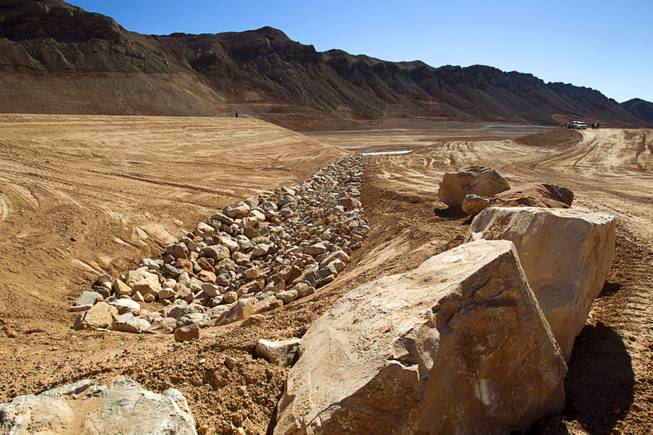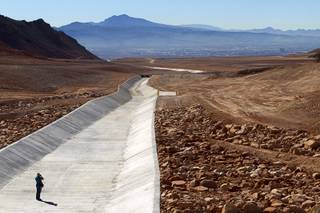
Flood control projects are shown on the top of Sunrise Landfill during a media tour Tuesday, Feb. 5, 2013. In 1998, a storm damaged the landfill cap, sending waste into the Las Vegas Wash and Lake Mead. The tour marked the completion of $36 million in storm control construction.
Tuesday, Feb. 5, 2013 | 5:07 p.m.
Standing on the Sunrise Landfill, a 440-acre swath of terraced land on the eastern fringes of the valley, one immediately notices the spectacular panorama, highlighted by the Strip skyline and snow-capped Mount Charleston.
Not noticeable are the 18 million cubic yards of waste buried there beneath dirt and rock. A former stench, which overwhelmed politicians and officials who toured the site 15 years ago and elicited numerous complaints from neighbors, no longer can be detected. Nor can you see any lingering aftermath of the disaster that struck in 1998, when a rainstorm washed garbage from the landfill into waterways that feed Lake Mead.
After years of studies, planning, court battles, even more studies and finally construction, an innovative new system for keeping the landfill secure is in place, pleasing local and federal officials and landfill operators alike.
In 1993 the landfill, operated at the time by Disposal Urban Maintenance Corporation Inc., stopped receiving waste. In 1995 it officially closed.
Steps initially taken to close and secure the landfill were insufficient, and on Tuesday, more than a decade later, officials unveiled the $36 million worth of work undertaken to prevent incidents like the one in 1998.
The Bureau of Land Management, which owns the land, the Environmental Protection Agency and other organizations were studying Sunrise before the 1998 storm, suspecting the site was not stable. They found the cap used to cover the landfill when it was closed was cracked. One fissure ran for 100 feet across the top of the landfill cover.
A BLM consultant measured explosive levels of methane, a common gas produced in landfills, and hydrogen sulfide, a gas with a rotten-egg odor. Sen. Harry Reid and other politicians toured the site a decade ago, covering their mouths and noses to block the eye-watering stench.
The original landfill cap was constructed of layers of clay and soil, a model found to be unsuited for the desert climate.
“That is something that was designed for the East Coast,” Steve Wall, project coordinator for the EPA, said Tuesday. “With that type of cover you need vegetation, grass, to prevent erosion. Without vegetation the soil just washes away.”
The desert environment combined with the soil’s high salt content necessitated a different strategy, Wall said.
Before anything could be done to improve the landfill’s cover, a drenching rainstorm hit the valley on Sept. 11, 1998. The 200-year storm, so named because a storm of its magnitude is thought to occur only once every two centuries, dropped 4 inches of precipitation on the landfill in six hours. Resulting floodwaters washed away the landfill’s soil cover, and exposed waste. An estimated 100,000 cubic yards of garbage poured into the Las Vegas Wash, polluting the water that feeds into Lake Mead.
Republic Services acquired Sunrise Landfill, and its problems, in 1997, when it bought the company that operated the landfill. After the 1998 storm, the EPA ordered cleanup and proper closure of the landfill. After years of legal wrangling over responsibility for the initial improper closure and what would be done to fix it, the EPA, BLM, Clark County and Republic Services signed an agreement in 2008.
A new cover was designed based on smaller landfills in other arid areas such as Arizona. Now there are different layers of rock and soil, and water is expected to seep into the ground to a certain depth and then evaporate. Other improvements include a new groundwater monitoring system, new landfill gas-monitoring system, a stormwater-control system designed for a 200-year storm and a basin with a dam for holding water designed for a 500-year storm.
The project to properly close the landfill began in September 2011, 13 years after the 1998 storm. The work, which was done by Las Vegas Paving Co., was completed on Jan. 31.
Sunrise Landfill took all of the valley’s garbage from 1953 to 1993. In those 40 years, 18 million cubic yards of waste were collected. By comparison, the Apex Landfill in use today has accumulated 60 million cubic yards of garbage in its 20 years of existence.
Besides paying the $36 million for the work on the Sunrise site, Republic agreed to maintain the landfill for 30 years, and it paid a $1 million civil penalty.
A BLM official said the plan now is to sell the land to Clark County by the end of the year for a “nominal price.”
“The Bureau of Land Management used to lease landfills, but years ago started conveying them to local agencies,” BLM environmental protection specialist Mike Moran said Tuesday. “With the urban encroachment all the way up to the borders of the site, there is no federal purpose this site serves at this point.”


Join the Discussion:
Check this out for a full explanation of our conversion to the LiveFyre commenting system and instructions on how to sign up for an account.
Full comments policy